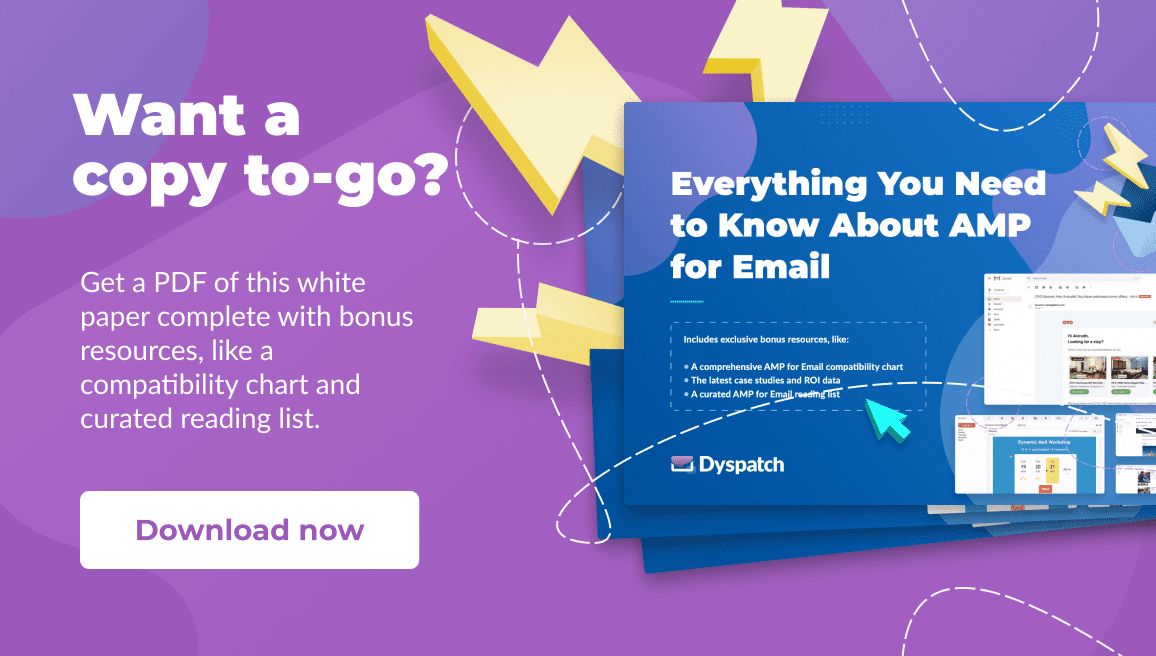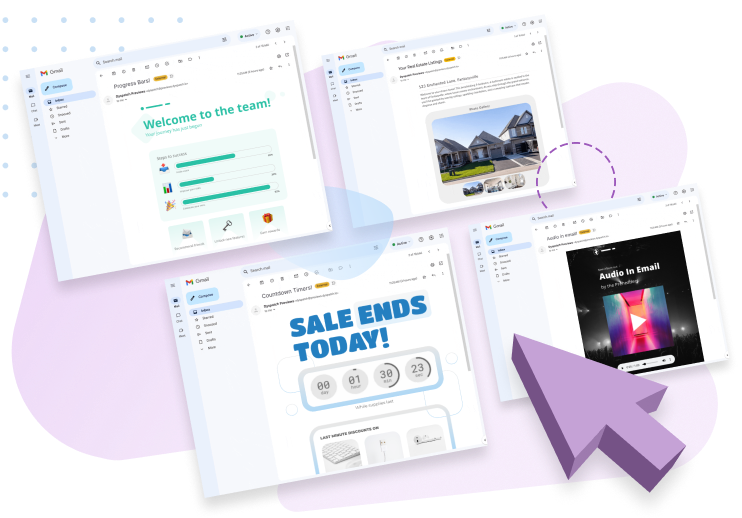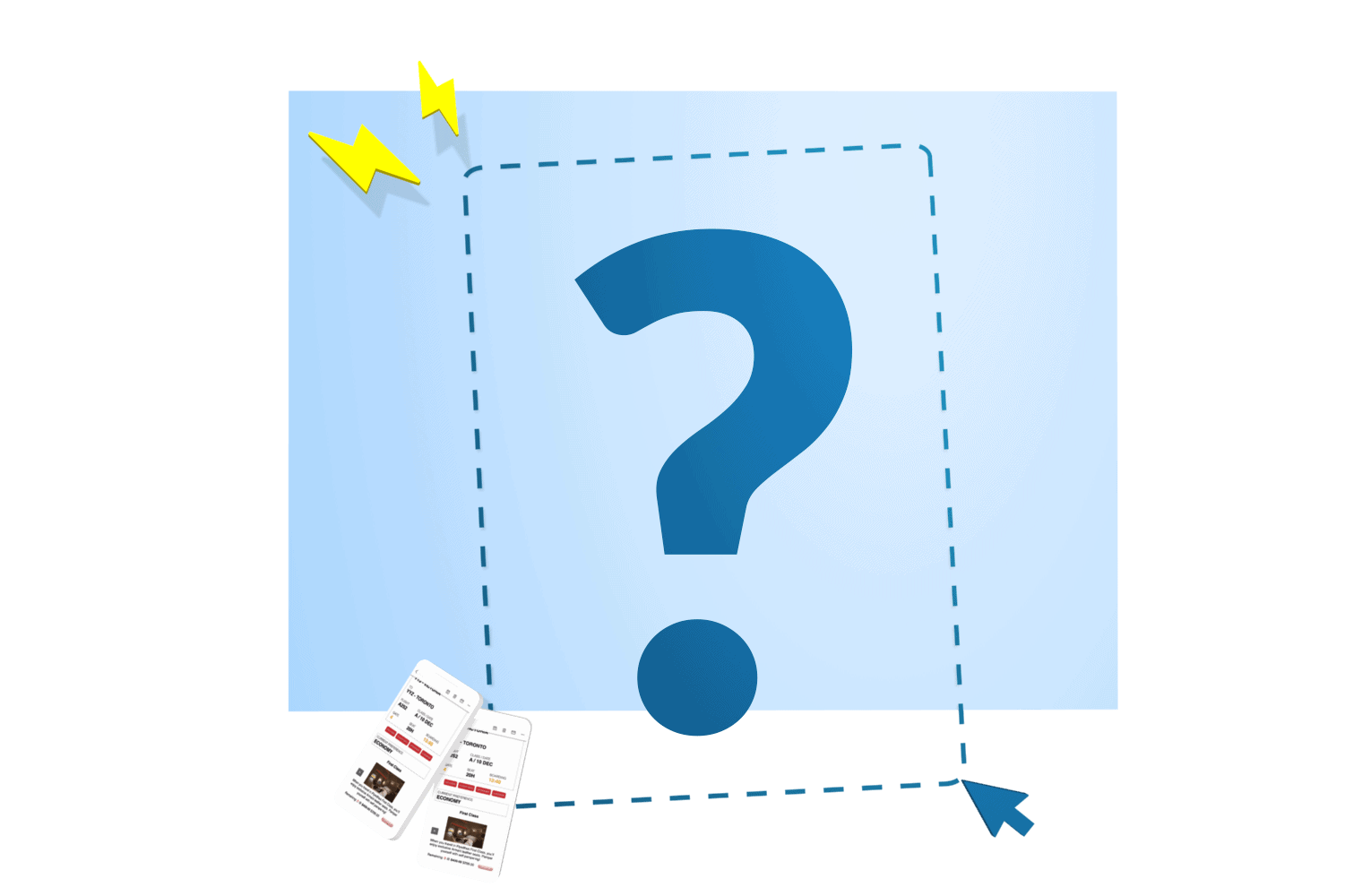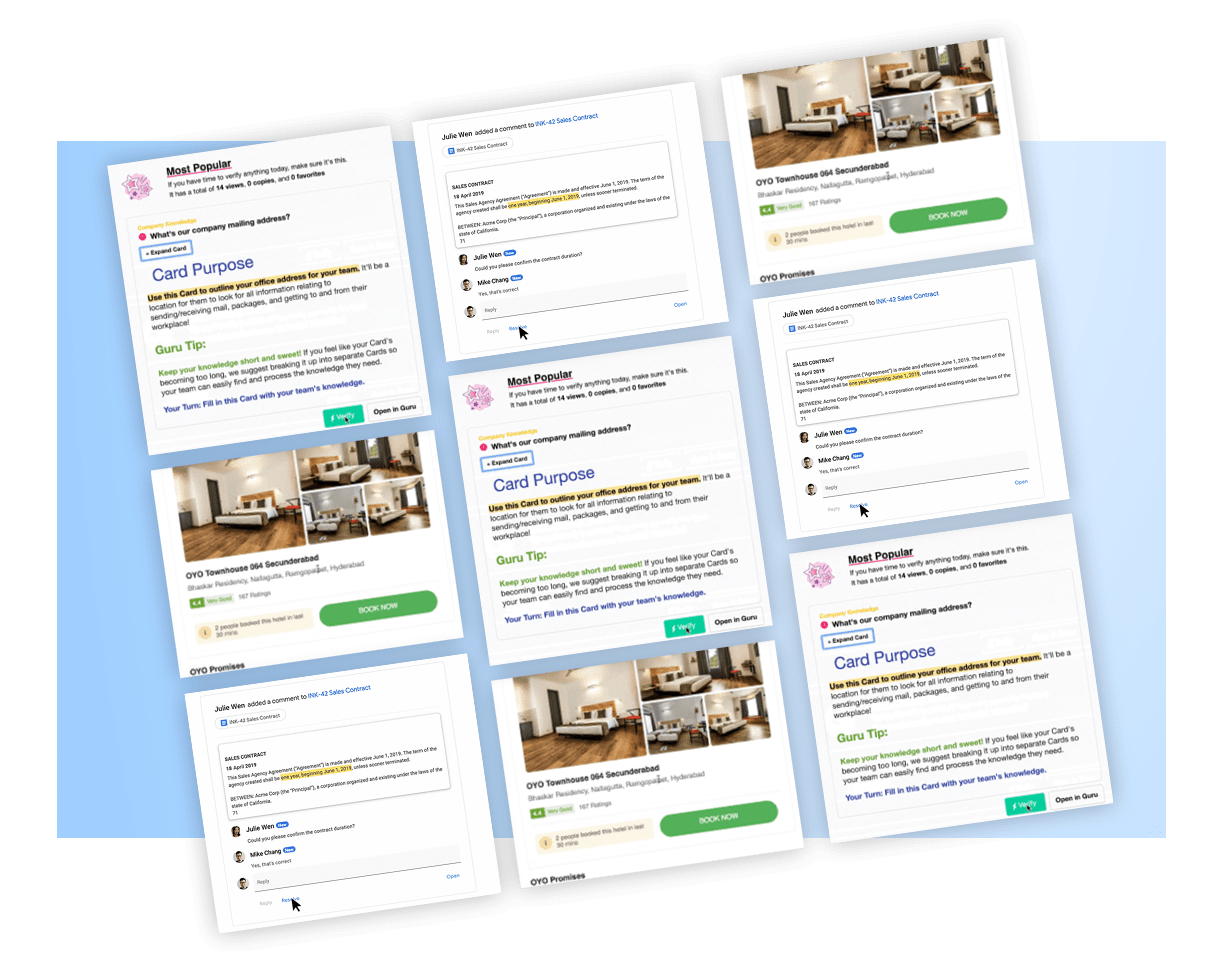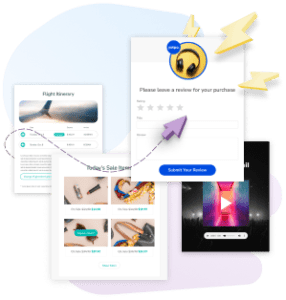
The Ultimate Guide to Interactive Email
What if your inbox was as dynamic as your favorite app? That's the reality of modern email marketing. Interactive elements are bridging the gap between static messages and rich web experiences, allowing brands to deliver personalized, engaging content right to your inbox.
Read now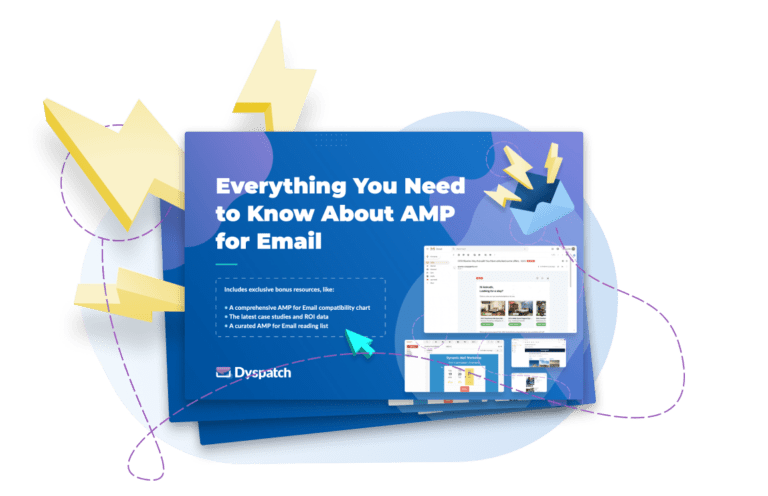
Everything You Need to Know About AMP For Email
Table of Contents
AMP for Email brings new functionality to the inbox for the first time in years.
Instead of static experiences, AMP allows you to serve live, interactive email content. No more click-throughs or stale messages. With AMP emails, users can submit information without leaving the inbox, and see the latest data every time they open a message.
Imagine an app-like experience — just, in an email. That's AMP. And that's why AMP is redefining transactional and marketing email campaigns.
Suffice to say, AMP is the biggest innovation to come to email technology since its inception, decades ago. By giving recipients the ability to interact with live content, directly inside an email, AMP eliminates the need to click through to a web page.
What does that mean for you? The possibilities are endless. Empower your customers to respond to a survey, right from an email. Or show only available real estate listings in your emails. Both of these use cases are completely new to email — and they're just a few drops in a tidal wave of new opportunities to maximize ROI from email.
Here are a few astonishing stats on interactive email to get you excited about the possibilities. According to our research:
60% of email recipients
said they are likely to engage with an interactive email
More than 50% of email recipients
want to interact with content inside their email
Source: Dyspatch
AMP Emails Will Redefine the Customer’s Inbox
It’s been a couple years since Google launched Accelerated Mobile Pages (AMP) for Email. This launch expanded on the open-source AMP technology that was previously limited to guaranteeing mobile web pages operate at optimal speed.
Since then, AMP has been gaining adoption. Leading brands have recognized the potential for revolutionizing traditional email marketing with brand new use cases. And with growing adoption in the market from email clients and ESPs, we believe AMP will be in all inboxes soon.
Maybe you've heard the buzz, looked into use cases, or even received some AMP emails in your own inbox from leaders in the space like Google, Pinterest, and Indeed. If so, you may be wondering whether it's worth investing in AMP for your company...
As an AMP-forward company, we may be biased, but the data isn't! And it shows AMP can increase engagement and conversions by up to 500%. (More on this in a moment.) So the answer is: absolutely.
AMP offers marketers new possibilities for engaging with their audience. It's the most powerful upgrade to traditional, static emails since the launch of HTML emails. And it’s been garnering a ton of interest and momentum in the digital landscape.
With AMP emails, your recipients are more likely to add an item to their shopping cart, RSVP to a webinar, complete a survey, or book something online because they don't have to leave their email inbox. So AMP is a winning strategy. But what are the best ways to leverage this new technology for your own business goals?
To help you elevate your email strategy, this white paper will explore everything you need to know about AMP for Email. Here’s what we’ll be covering:
- What is AMP for Email?
- What Can You Do With AMP for Email?
- Benefits of AMP for Email
- AMP for Email Use Cases: Transactional and Marketing Emails; B2B and B2C
- AMP for Email Case Studies and ROI
- AMP Emails: The Pros and Cons
- A Step-By-Step Guide to Implementing AMP for Email
- AMP for Email FAQs
- AMP is the Future of Email
We'll provide you with an expert view of AMP, and cover all the insights you need to decide how and when to invest in sending AMP emails. Let's get started!
Elevate customer experiences with AMP for Email
Create engaging experiences by bringing interactivity into email. And do it all easily, with our library of pre-coded, interactive email apps and easy to use AMP email builder.
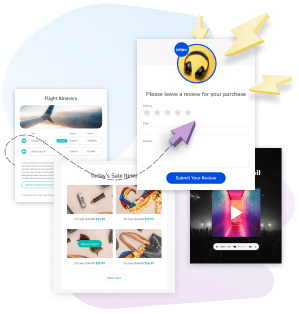
What is AMP for Email?
Let’s start with the basics. What was AMP for Email created to achieve, and how does it work?
(Note, we’ll also cover a longer list of specific AMP email uses case in a moment.)
Google originally developed AMP in 2015 as an open source technology designed to boost page loading speeds on mobile devices. In 2018, Google announced AMP-powered email so users could have interactive email experiences without leaving their inbox.
With AMP elements, users can take a survey, respond to an invitation, reply to a comment, or zoom in on products. Clickable interfaces built into messages allow users to browse and explore content, without having to leave an email or visit a landing page.
AMP for Email also enables time-sensitive emails — like job listings or polls — to only show current, live content. This means, no matter when a user opens an email, they'll always see the most up-to-date information. Recipients won’t miss out on that sofa sale or dream job ever again!
Important Note: Not All Interactive Emails Are AMP Emails
Interactive email, also known as 'kinetic email', refers to a set of advanced techniques for adding interactive functionality into HTML emails. A common example of interactive email is adding an image carousel or video into an email. It’s relatively simple to set a fallback, so recipients who can’t view interactive email (for example, those who use limited email clients like Outlook) will still have a good experience. Now, AMP emails are interactive, but there's a distinction to be made between just an interactive email and an AMP email. More on this below!
Gifs and videos are a common example of interactive elements in email that have been proven to increase engagement by up to 300%. But AMP email takes interactivity far beyond what you can achieve with gifs, videos, and personalization.
There's a common misconception that AMP is just for creating interactive elements in an email. While it’s true AMP simplifies the code for most interactive emails, AMP technology also offers entirely new possibilities.
AMP for Email’s true strength is bringing live data into emails, so your readers only receive up-to-date information. We’ll go through several examples in this white paper to show you how AMP emails provide a superior user experience, and ultimately, drive engagement and conversions. But first, let's unpack the differences between AMP and interactive email a little further.
Key Differences Between AMP and Interactive Email
- Interactive emails are just HTML, which means everyone will see them no matter what email client they use — as long as they've enabled HTML. Some recipients may be using screen readers, or have other reasons for viewing the plain text version of your email.
- Certain email elements, like carousels and forms, are already possible with interactive email. AMP offers new functionality in carousels, like auto-scrolling.
- AMP’s real strength is that it can pull live data into the email, making it dynamic and up-to-date. Interactive emails don’t have this capability. Interactive emails are always static, with data that reflects the date and time at which they were sent. AMP emails show data that applies to the moment the recipient opens it, since it pulls from the sender’s data source.
Related: Dynamic, Interactive, and AMP Emails: What's the Difference, Anyway?
AMP Under the Hood
When it comes to creating the actual emails, AMP calls for an extra level of coding. This is considered a third layer.
Plain text is the version accessible to all recipients, even those with HTML disabled. HTML is the email we’re used to seeing, with images and rich text content. And AMP is the third layer, given priority. That is, the AMP layer will show with priority given the correct circumstances.
Typically, email marketers have to create an HTML version and a plain-text version of every email. Then, they send it through their email service provider (ESP), which uses two different MIME-types. AMP is a third MIME type. Creating emails using AMP requires a separate MIME-type: text-x-amphtml. This MIME-type is what makes the interactivity magic happen.
Every AMP Email Must Have an HTML Fallback
Creating an HTML fallback for AMP content is essential. It ensures a seamless inbox experience for all recipients.
Here are the cases to cover with a fallback:
- AMP emails expire after 30 days. If the email is opened — for the first time, or any additional time — after those 30 days, the recipient will see the HTML (or plain text) fallback.
- The fallback is essential for recipients using email providers that don’t support AMP. This may represent few of your recipients. Depending on your industry, Gmail (and, at work, G Suite) is far and away the leader in the industry. For an up-to-date list of email providers that will display AMP content to users, visit this page.
- Forwarded emails won’t show AMP. If a recipient is excited about AMP content and forwards the email to another person, that person will only see the fallback.
As you can see, there are a select few scenarios where recipients may see the fallback content instead of the AMP version. The takeaway? It’s important to ensure the HTML fallback version succeeds as a standalone email too.
Testing AMP Emails
There are two keys to testing AMP email content. In order to see a test version of an AMP email:
1. The sending email address needs to be approved to send AMP by Google.
2. The recipient needs to enable dynamic emails (in their settings).
Once these criteria are met, testing on different device and provider combinations will provide a more granular view of your AMP email content and its HTML fallback.
For testing, Litmus is the leading device previews platform out there. You’ll often find Litmus previews bundled into email production platforms, like Dyspatch. That said, Litmus doesn’t currently power 'deliberate' AMP renderings, so testing in your own inbox is essential. What do we mean by that?
Simply put, Litmus device previews show the AMP version if you select a provider combination that supports it. (And the other criteria are met, like the sending email address is approved, etc.)
In the future, Litmus may add an option to test the AMP and HTML fallback version of every email. But until then, it’s up to us to make sure we check everything thoroughly.
What Will Brands Achieve With AMP?
At its heart, email marketing is so much more than just sending out information or pushing the daily deal. Email is where you drive engagement, build brand trust, and increase customer loyalty — all of which have a long term impact on your business.
When Google created AMP, their goal was to elevate the customer experience. And this presents such an exciting evolution in email. AMP for email brings app-like experiences into email, making it possible to take action without clicking away.
At first glance, this may not seem like a profound shift. But by embedding your high value conversion points directly into emails, you create a frictionless experience for the user — a big upgrade in terms of UX.
You're also shortening the conversion funnel. This results in fewer drop-offs and more conversions. AMP aims to do both. By removing friction points in the funnel, email recipients can complete actions faster. Whether it’s adding products to their cart or filling out a form to request a product demo, AMP reduces the path to conversion.
How can removing the simple action of clicking from an email to a website have such a big impact on engagement? Beyond sheer convenience, there are also fewer steps where something can go wrong.
For example, how often do you check your email while you’re on the go? Spotty wifi can slow load times. And if a browser doesn't launch fast enough, you're more likely to abandon the task at hand.
Here's another friction point: often, you need to log in to take action from the browser. How often do you give up on logging into a service when your phone or password manager doesn’t remember your password? According to a study done by Mastercard and The University of Oxford, about a third of online purchases are abandoned at checkout because consumers can't remember their passwords.
These friction points make a big difference and impact your bottom line. Implementing AMP removes all that friction. By making it easier for your recipients to engage with your service, AMP may very well lead to surprising results. Namely, more engagement and conversions. (We'll share some examples with results in just a sec!)
What Can You Do With AMP for Email?
There are many compelling use cases for AMP email. Below, we discuss a few examples to help inspire you. Take a sec to think about how these use cases could be applied to your business to improve results. The beauty of AMP is that there are very few limitations. Around here, we like to say "Truly anything is possible." So let’s get creative!
Related: AMP for Email Use Cases for Every Vertical
Here are just a few of the interactive elements found in AMP emails:
Forms
Forms are one of the best use cases for AMP with a proven ROI.
The classic example of AMP forms comes from Google. Most of us are familiar with Google Docs notification emails from G Suite. In these emails, you can add a comment or resolve a comment right in the email, without clicking through to the actual document.
This is a stellar productivity use case. It provides a lot of convenience and efficiency for google doc users and can be applied to other apps, specifically SaaS products. Productivity use cases may not be directly tied to revenue, like AMP marketing emails. But these use cases are on the rise.
Why? Because they result in higher engagement metrics and increased collaboration. Ultimately, they make your product stickier and more effective. What's more, all of this added value will likely lead to better customer retention and a higher customer lifetime value. (We cover some more productivity use cases later too.)
Related: AMPed Up Emails Series: Driving Growth With Productivity Emails
Aside from convenience and efficiency, there are countless ways AMP forms can be leveraged to increase conversions.
We’ll start with the results of an A/B test. This test involved sending an email to 23 thousand recipients in total. The first half of the list received an AMP email with an embedded form. The email recipients could submit this interactive form right from the email. The second half received a non-interactive HTML version. These recipients had to click to the website before submitting the form. The results showed that the AMP email generated 5.2X the number of form submissions. This is significant considering the only change was not having to click through to submit the form.
Here's a survey example using an AMP form:

Source: Dyspatch
Some great ways to leverage AMP forms are:
- Webinar registrations
- Event RSVPs
- Account creation forms
- Team member invitation forms
- Commenting in productivity notifications
- Surveys
- NPS surveys
- Feedback forms
- Demo request forms
Any form you have on your website can be added to an email! And at a 5.2X conversion rate, imagine how many more webinar registrations or demo requests you could get from sending AMP email forms?!
Related: How to Build AMP Forms in Email and 5x Your Responses
Carousels and Slideshows
Carousels and slideshows allow your readers to browse through live product lists or listings. To be clear, the AMP portion of a carousel is the dynamic content. That is, the live list of products that gets updated when a recipient opens the email. You can have a more basic, non-AMP carousel with pre-selected products. But with static lists, the risk is that your audience sees out of stock products or unavailable listings.
An AMP carousel ensures your audience always sees up-to-date information by pulling in current products or listings. For example, with AMP, you can safely promote sale items that are low stock. This is a great AMP use case. You’re preventing this situation: your reader clicks on an item and gets directed to a product page... only to realize the product is no longer available.
We’ve all had this type of experience before, and it’s not fun! Excitement quickly turns into disappointment. And it's well-established that brands who over promise and under deliver end up with lost revenue and low retention. To avoid this kind of experience and serve a positive one instead, AMP for Email is the answer. It allows you to promote deep discounts, clearance items, and limited listings, that would be risky to include in an email otherwise.
AMP image carousels also offer subtle new UI flourishes, like auto-scroll. This makes the carousel experience more engaging.
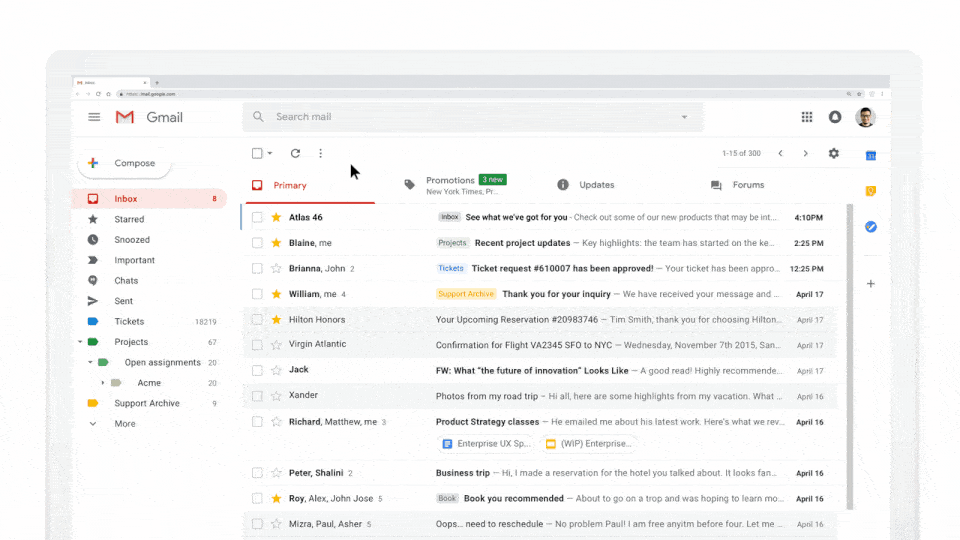
Source: Amp Blog
Related: How to Build an AMP Carousel in Email to Add Interactivity
Accordions
Accordions give you the ability to add a lot of content to an email without overcrowding it. Best practices for email state that simpler is better and less is more. This is true! You don’t want to overwhelm your audience with a crowded email with multiple CTAs, but it’s an easy trap to fall into.
Accordions are a great solution to the dilemma about how much content to add to an email. You can keep your email minimalist, while including all the great content you want to show. The only difference is your reader can pick and choose what they browse based on their interests.
For example, let’s say you have a real estate business, and you have listings in various neighborhoods in the city. With an accordion you could use a clean, uncluttered layout and show a single image to represent each neighborhood. The reader would then view active listings in their neighborhood of interest by clicking on one to show all the listings in that area. By using an accordion powered by AMP, you can pull active listings and their current availability into the email under each category — and show only up-to-date, reliable information.
This is especially important given that Gmail will clip messages that are over 102kb in size for traditional HTML emails and 200kb for AMP emails. In order to guarantee your content will be displayed, give prominence to what’s most important in your email.
Here's an example of an AMP accordion. Booking.com, a hotel and accommodation booking site, have used a high level interactive menu at the top. The reader can first select the location: domestic or international. Then, they use an accordion for each city to allow the reader to see more listings in that city.
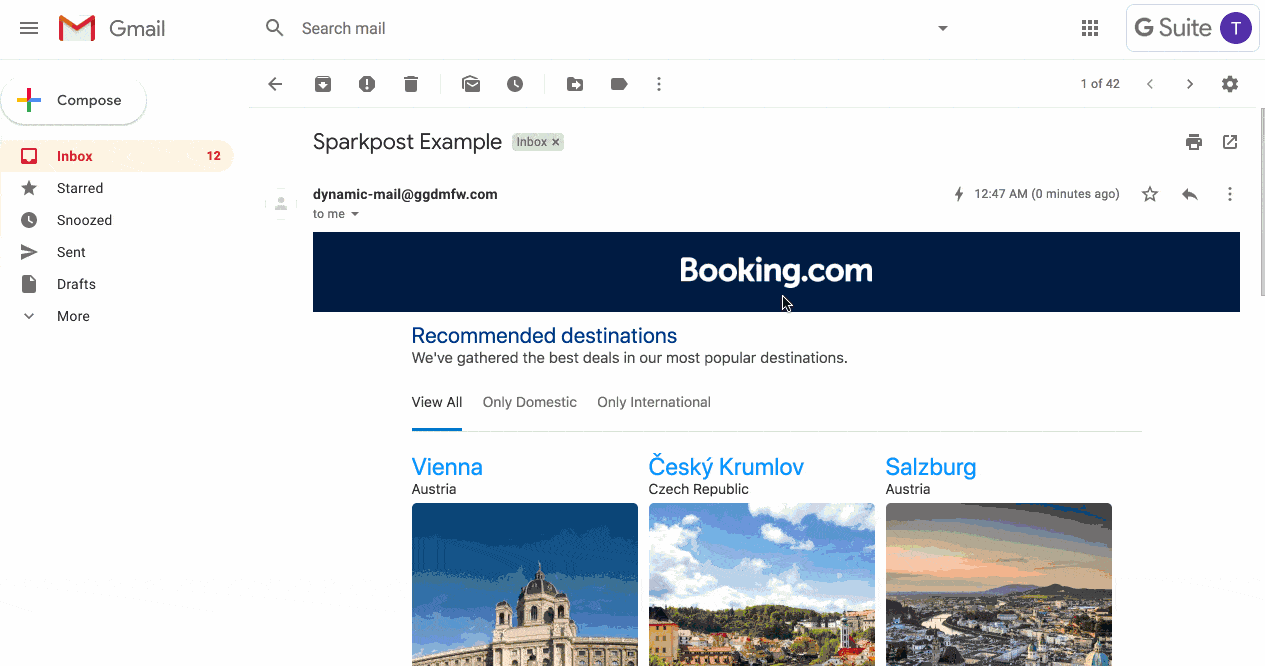
Add to Cart
Add to cart AMP email functionality brings the convenience of online shopping to a whole new level. But first, let’s take a look at the current state of things:
The course of selling products never did run smooth…which is probably why Baymard Institute found 69.82% of online shopping carts get abandoned. Friction points in the online purchase funnel are the bane of e-commerce brands everywhere. From forgotten log-ins to overly complicated and convoluted check-out processes, there’s no shortage of factors that can deter customers from completing a purchase.
To counter this, many companies employ cart abandonment email drip campaigns in an effort to corral customers back, with most enjoying some level of success. But what if you could shorten the path to purchase right from the get-go, right from within customers’ inboxes?
AMP’s add to cart actionability gives brands the power to dramatically condense the online shopping purchase funnel. By allowing customers to add items to their cart directly from an email, any necessary clicks to action are reduced, which in turn reduces the amount of friction users experience.
In other words, AMP emails equal convenience. And convenience equals conversions. Take a look at Google’s AMP-powered Nest email campaign:
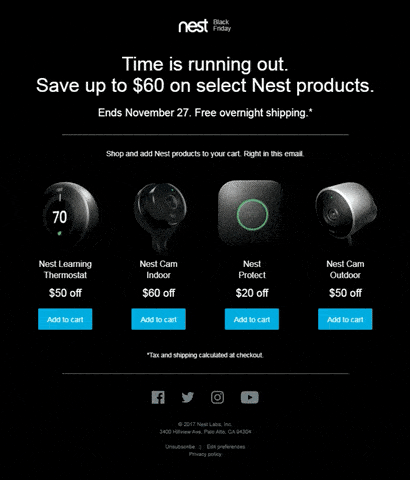
Besides demonstrating the ease with which AMP add to cart emails work, this example shows an added benefit that comes with their use: The ability to pair add to cart actionability with various types of email copy. Here, an additional layer of urgency is created by combining the add to cart feature with their “Time is running out” sales messaging. You can bet those interested in saving would be quick to capitalize on the opportunity.
From new product releases and personalized recommendations to sale announcements and reminders, AMP Add to Cart emails create incredible value for companies. And all while boosting the convenience and ease-of-use factors for subscribers.
Oh, and those cart abandonment drip campaigns? Well, a case study showed AMP abandoned cart emails increased recovered sales by 82% on average. Check out the section on AMP ROI for more information!
Live Product Lists
Live product lists powered by AMP reduce the pain points associated with promoting products, services, or listings over email by dynamically pulling in information the moment an email is opened. This eliminates the disappointment and frustration that comes when subscribers click-through on an already sold-out product, or find out a product’s price differs from what was advertised.
(And those with experience on the customer service end of such issues know just how game-changing this could be!)
With AMP product lists, you’ll never have to worry about advertising stale, irrelevant content again, or double and triple-checking inventory in the days leading up to a campaign (nevermind the time spent making last minute edits). Out of stock products and unavailable listings are dropped or swapped out automatically, and low stock alerts can appear in-email as soon as inventory dips. Price updates are similarly synched and applied automatically, saving you the hassle of price-matching or apologizing.

In other words, by reducing the roadblocks to purchase, you’ll boost engagement and revenue effortlessly. And that’s without getting into AMP’s excellence at driving sales via personalized recommendations and upsells!
Related: Building AMP Emails Series: Dynamic Lists
Live Commenting
Live commenting lets users reply to message threads right from their email by dynamically pulling in data to display the latest updates. As mentioned, it’s one of the most widely understood AMP use cases owing to GSuite’s live commenting integration within Google Docs email notifications. And when it comes to ROI, the productivity increases are undeniable.
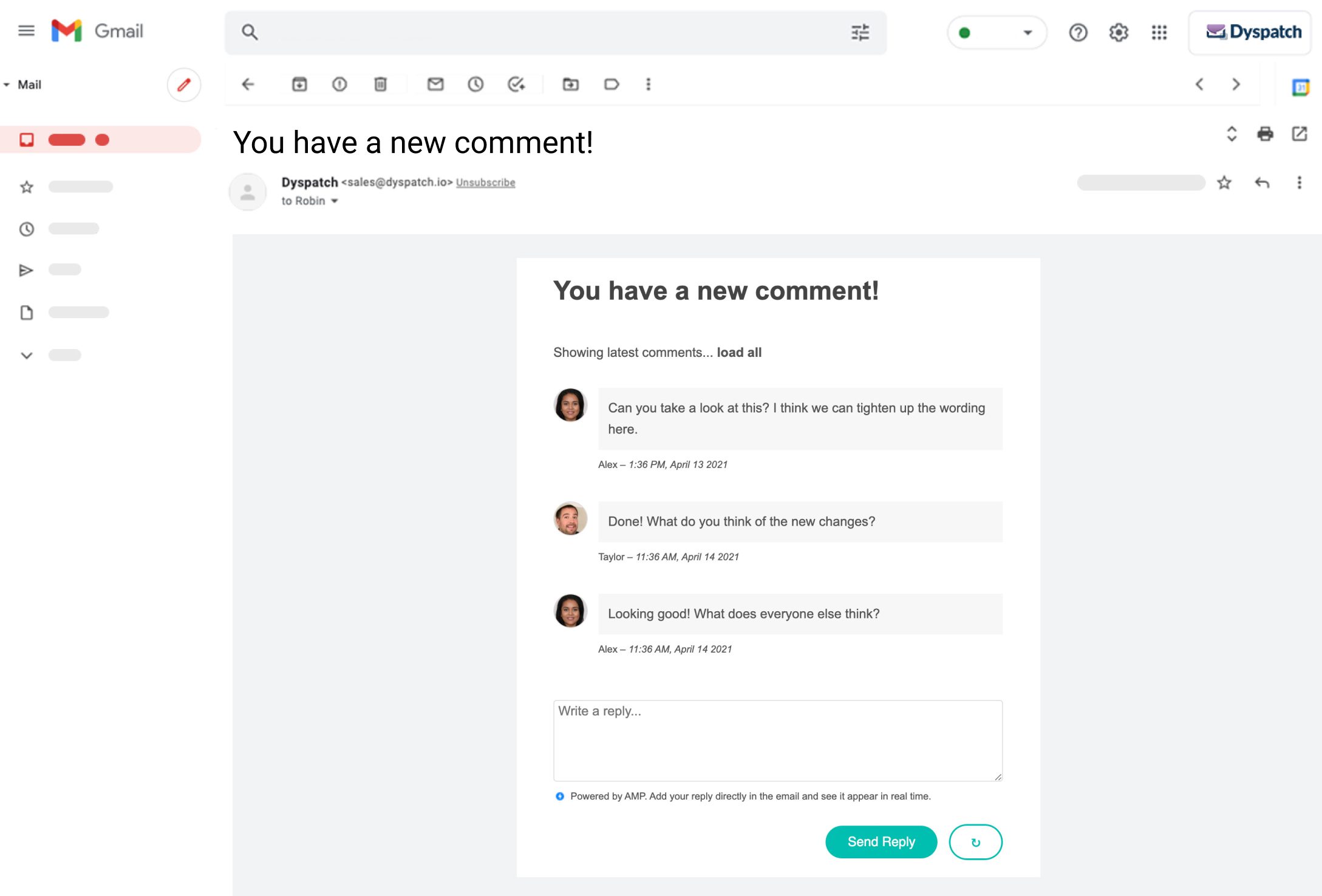
Simply put, live commenting lets you get things done a lot faster. There’s no need to click-through and open up new tabs, or shuffle through your Drive just to find the correct document. You don’t have to scroll through pages to track down the right comment. And you also don’t have to deal with any miscommunications stemming from someone missing the most recent exchange on the page.
Each added step disrupts your workflow and detracts from productivity. And while that doesn’t sound like the most laborious chain of events in the world, it still adds up.
By allowing users to reply directly from your inbox, you proverbially grease the wheels of your business. So whether you’re a B2B company looking to enhance workflow efficiency, a B2C company who could benefit from live chat support, or anyone hoping to enhance user experience and productivity while reducing friction and confusion, live commenting powered by AMP for Email is your best bet.
Again, you can lean more about the productivity boost AMP live commenting emails create in this case studies and ROI section.
Related: How SaaS Companies Can Benefit From AMP Emails
How Will AMP Emails Drive Conversions?
AMP for Email is all about engagement and ROI, right? Right! So let’s dive into the example from Booking.com above and ask some important questions...
How will interactive, dynamically powered email drive conversions? Will the reader just click to the webpage and drop off at that point instead of in the email? With this email, it's all about engaging the reader, and doing so fast.
First, it uses a lot of visuals and very little text. This is likely to catch the reader’s attention. After all, we process visuals 60 thousand times faster than text. Second, the reader can start browsing right away — as if they were shopping on a website — which is an action that increases both interest and intent. The idea is, by the time they get to the website, they're a lot more serious about following through.
Here are a few examples that illustrate how AMP can move your conversion metrics up and to the right:
Calendars make it easy for your leads and customers to book a demo or a meeting with you, right from an email.
With traditional emails, there's often a lot of back and forth to find a suitable day and time for both parties. It’s not just a click that acts as a friction point. It’s having to wait for a response, and check your calendar multiple times, before making it official with an invite. With AMP calendar emails, you could invite your prospect to get all this done, directly from one message. Although there isn’t much data on this AMP use case yet, it’s clear the impact could be huge.
Another calendar use case is making reservations based on current availability — ideal for restaurants, spin and yoga studios, airlines, and more. This type of AMP-powered email is a big time saver and offers a lot of convenience.

Gamification is often associated with fun, light-hearted emails designed to increase brand awareness and entertain readers. This is a great use of gamification! But gamification can also be used for driving conversions through fun quizzes, crosswords, and more.
For example, take a look at the email below. If the reader flips all the squares in the email correctly, they’ll expose a discount code. This puzzle was created by implementing an AMP carousel. And it’s a perfect example of how gamification can be used to increase conversions.

Source: Email competitors
As promised, we’ll explore some more specific use cases next. You'll discover exactly how companies are using AMP — and the ROI they've been seeing.
The Benefits of AMP for Email
Let’s jump right in by looking at some dynamic stats:
- Consumers open emails with personalized subject lines at a 50% higher rate compared to emails without a personalized greeting. Yet only 2% of emails employ personalization.
- Dynamic email marketing campaigns using segmented customer information have 14.64% more open and 60% more click-through rates compared to mass email blasts.
- Including video in email can increase your open rate by 19% and your click-through rate by 65%.
- According to Salesforce, 84% of customers say being treated like a person, not a number, is key to winning their business. And AMP helps you create highly personalized, immersive campaign experiences.
Don’t let your competition beat you to reaping the rewards of AMP for Email! Out of 56% of marketers familiar with AMP, nearly a third said they’re likely to use it. So get flexible, get responsive, and revitalize your email campaigns by leveraging AMP.
After all, the number of global email users is set to grow to 4.48 billion by 2024. So as the old saying goes, there’s no time like the present. This is your chance to develop next-gen expertise well ahead of the pack.
AMP for Email Use Cases for B2B and B2C
As you can see from the examples above, many industries and business types can benefit from AMP email. This includes both B2C and B2B companies. Although the former may be the most obvious with the quick sell advantage, B2B companies can also profit from AMP.
Let’s look at a quick comparison of each business type:
B2B
Leveraging AMP-powered emails gives B2B companies a way to stand out in their leads’ inboxes, and helps remove some of the barriers in the sales funnel. For example, B2B companies can use AMP email to drive new user adoption of their product or collect product feedback. To get your gears turning, we've rounded up some examples below.
A few ways B2B companies can reach out and engage with their audience include:
- Events — Have users quickly RSVP through an email. An easy-to-use form and submit button is key to a large turnout to a webinar or event. As noted above, this approach could collect 5.2x the amount of responses than if the recipient had to click away to sign up.
- Demos — Use an AMP list and form to make booking a demo really quick for your leads, and directly attribute your increase in demos and sales to AMP.
- Comments — By using an AMP list and form, you can allow your app users to make comments and complete other actions from an email, bringing the data to where you work, in your email.
- Surveys — Skip SurveyMonkey and grab the recipient’s attention right at the start. Google Forms have been using AMP surveys to allow users to reply from an actual email, boosting their response rate. This tactic is now available to any AMP sender.
- NPS surveys — Increase your response rates on Net Promoter Score (NPS) surveys by embedding them right in an email. This is a great use case for B2C businesses as well. If you're not sending NPS surveys, you may want to consider starting. Monitoring your NPS score will help you gauge loyalty and retain more customers long-term.
- Polls — Similar to surveys, but shorter and sweeter. Interactive email polls are an excellent way to gather quick feedback. And with Dyspatch's Poll in Email app, you can add interactive polls to your templates with little to no engineering effort. For more inspiration on the different ways to use email polls, check out these 9 powerful use cases.
- Onboarding flow — Increase new user adoption by using an AMP onboarding email sequence. Help new product users complete onboarding steps, such as making preference selections or inviting team members in an email.
- Product feedback — Make it easy for your users to provide product feedback by submitting it directly from an email.
- Requests for reviews — Save time manually chasing down customers and increase your review request response rate using an AMP form.
Related: AMPed Up Email Series: B2B Sales & Marketing Use Cases
B2C
Here’s a look at some common B2C campaigns, and what they can achieve by employing AMP:
| Email Focus | Campaign ideas |
|---|---|
| Ecommerce products | Show only ones in stock, could also show up-to-date in stock quantities to create urgency |
| Bookings/reservations | Use calendars embedded in an email to book just like you would in an app — ideal for fitness classes, restaurants, real estate viewings, hotel bookings, and more |
| Product sales | Use discount codes with gamification to increase engagement of your promotional emails |
| Upsells | Include upsells in both transactional and marketing emails based on previously viewed products |
| Recommended products | Use your customer purchase behavior to share personalized product recommendations and boost sales |
| Referral campaigns | Empower your email recipients to easily refer friends by allowing them to send incentivized invites to people they know |
| Product reviews | Request a review via form, or show product reviews pulled from product listings to build trust and increase sales |
| Abandoned cart campaigns | Include previously viewed items in an email and allow recipients to add the items to their cart |
| Newsletters | Include any kind of interactive content to make newsletters more engaging |
| Loyalty programs | Encourage loyalty program members to fill out their profiles and include live reward counts, tier status updates, and personalized recommendations to boost engagement |
Related: How On-Demand Services Can Benefit From AMP Emails
AMP for Email Use Cases for Transactional Emails
While most AMP for Email use cases are for marketing emails (like the ones listed above), AMP for Email can also be used to increase the effectiveness of transactional emails. Check out some ideas below:
| Email Focus | AMP elements | Campaign ideas |
|---|---|---|
| Status updates | List |
|
| Upsell emails | Gamification, carousels, accordions |
|
| Managing app preferences | Form |
|
AMP for Email Case Studies and ROI
So, who's using AMP for Email and to what benefit?
Let’s dive into some real use cases. As mentioned previously, a mix of B2C and B2B marketers have embraced AMP with some impressive results. We’ll cover examples that span productivity, marketing, and transactional emails.
AMP Productivity Case Studies
Google Docs
Google started using AMP for Email for their cloud-based documentation tool Google Docs. Previously, any collaborator on a doc would receive an email each time there was a new comment in a thread. Then, they would have to click through to the actual doc to reply to or resolve a thread. With AMP, users can view and reply, comment, or resolve right within an email message. And, no matter when someone opens an email, they'll see an updated thread. Skipping the step of having to go to the doc itself resulted in a 500% increase in comment reply rate.
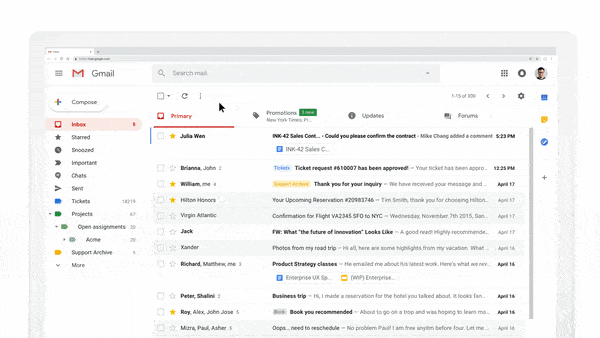
Guru
At AMP Fest 2020, there were some exciting new AMP case studies, including how Guru, a knowledge management system, uses AMP to increase productivity. Guru sends tens of thousands of email notifications every day. By making these emails dynamic using AMP, they were able to increase card comment actions by 2.5x, and increase card verifications by 75%! This translates into thousands of additional actions that are helping users be more productive — and manage their knowledge base without leaving the inbox.
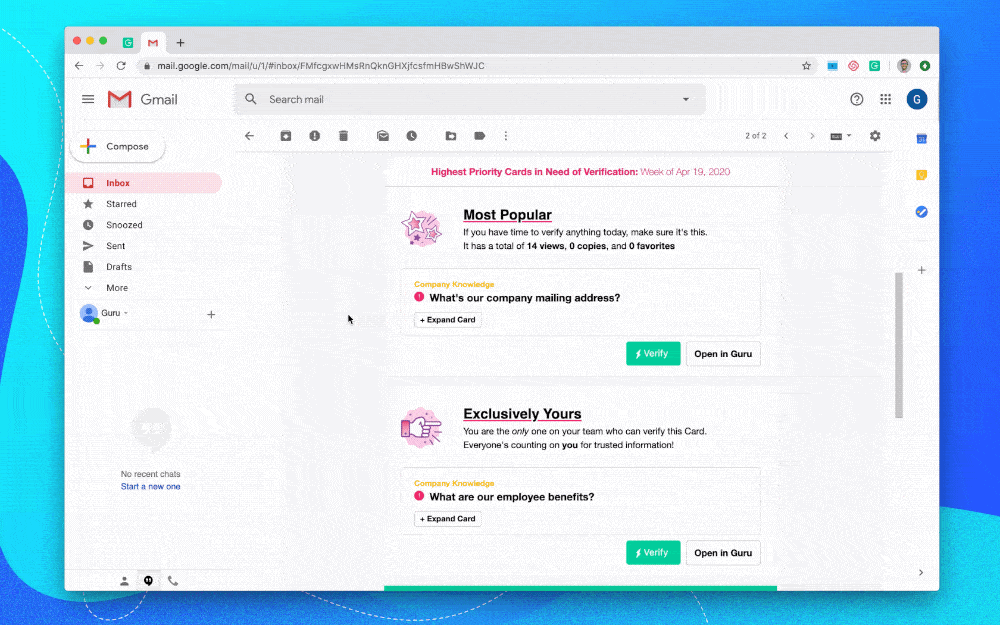
Source: Google Developers Blog
VOGSY
VOGSY is a Professional Services Automation Platform (PSA). VOGSY supports 60 different workflows with multiple different paths. To help streamline these workflows, they send approval and notification emails that prompt recipients to take action. Normally, an action takes on average one day to complete. But since deploying AMP and transforming these emails into actionable, interactive content, they've seen the speed at which an action is completed improve by 80%. This translates into actions being completed within hours, instead of days.
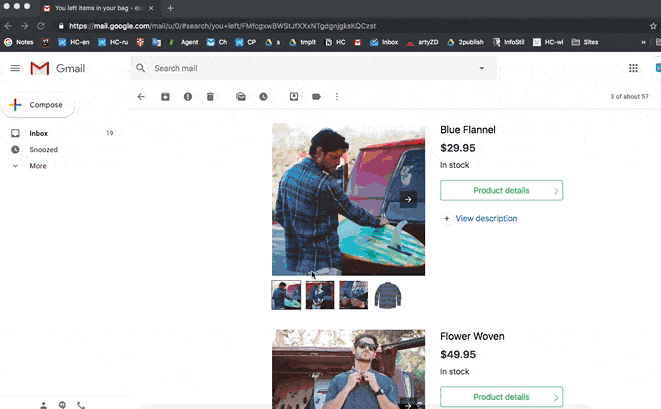
Source: AMP Fest 2020
AMP Marketing Use Cases
OYO
India travel booking site OYO uses AMP to show travelers accommodation recommendations. These recommendations can be for business travel or for escape destinations. With AMP, users can browse options and see larger photos of suggested lodgings. They can also confirm check in and check out times, whether breakfast is included, and whether there’s free WiFi, all within email. Eliminating the website jaunt clearly paid off: OYO achieved a 57% higher click-through rate and a 60% higher conversion rate.
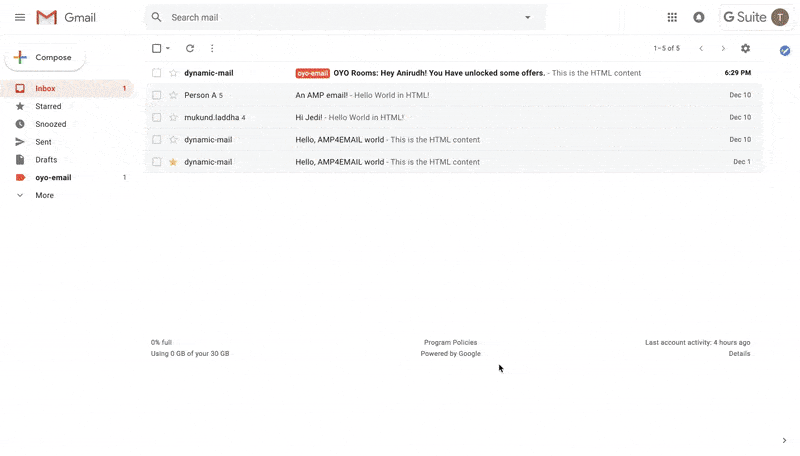
Doodle
Doodle is an online platform for time management and coordinating meetings. AMP is a game-changer for Doodle. It has allowed them to add scheduling functionalities right inside their email messages. For example, if a user creates a poll in Doodle, all of the invitees will get an email, including the creator. People can vote in the email messages and will get timely information about poll engagement. Basically, everything Doodle's app could do has migrated to email, saving users extra steps, and most importantly, time.

Ecwid
Ecwid, an ecommerce platform, has helped many of its merchants send AMP abandoned cart emails. With AMP abandoned cart emails, they've seen recovered sales increase by on average 82%. One merchant in particular noted they were able to increase recovered sales by 300%! In the example below, email recipients are encouraged to continue down the sales funnel in the email, paving the way to a smoother checkout experience.

Source: Ecwid
Razorpay
Razorpay, a full-stack financial solutions provider, improved their survey response rate by 257% with AMP emails. As the company grew their suite of products, they knew it was crucial to gather feedback from their customers. But their original survey emails included multiple steps and redirections, so customers would often drop off before completing the process. By bringing the entire survey flow into the email body, they improved and simplified the user experience. Razorpay has also seen success using AMP emails for lead generation and product awareness. They converted 87% more merchants to the platform by embedding interactive forms in their emails and increased engagement on their product awareness campaigns by 45% with AMP carousels.
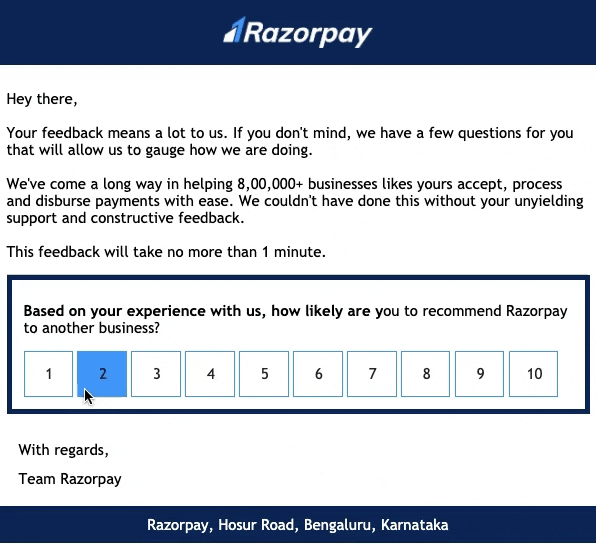
Source: AMP developers blog
Findomestic
Findomestic, a consumer credit company, leverage interactive AMP emails to help their customers choose the right banking product, right from their inbox. Their marketing team improved conversions by allowing users to calculate the financial rate of a new loan within an email. To gauge the success of their AMP emails, Findomestic ran an A/B test. Group A received a standard HTML email that directed users to their website to calculate a loan. Group B received a dynamic AMP version of the email where users could interact with multiple elements. They could choose what their loan was for, and get a preview of the best available offer. The results were notable: An open rate increase of 128% and a click rate increase of 133% for the AMP version of the email. Interestingly, they also found users opened the AMP email several times. Findomestic postulated this was because the dynamic nature of the AMP email attracted attention and encouraged users to come back and play around with the built-in tool.
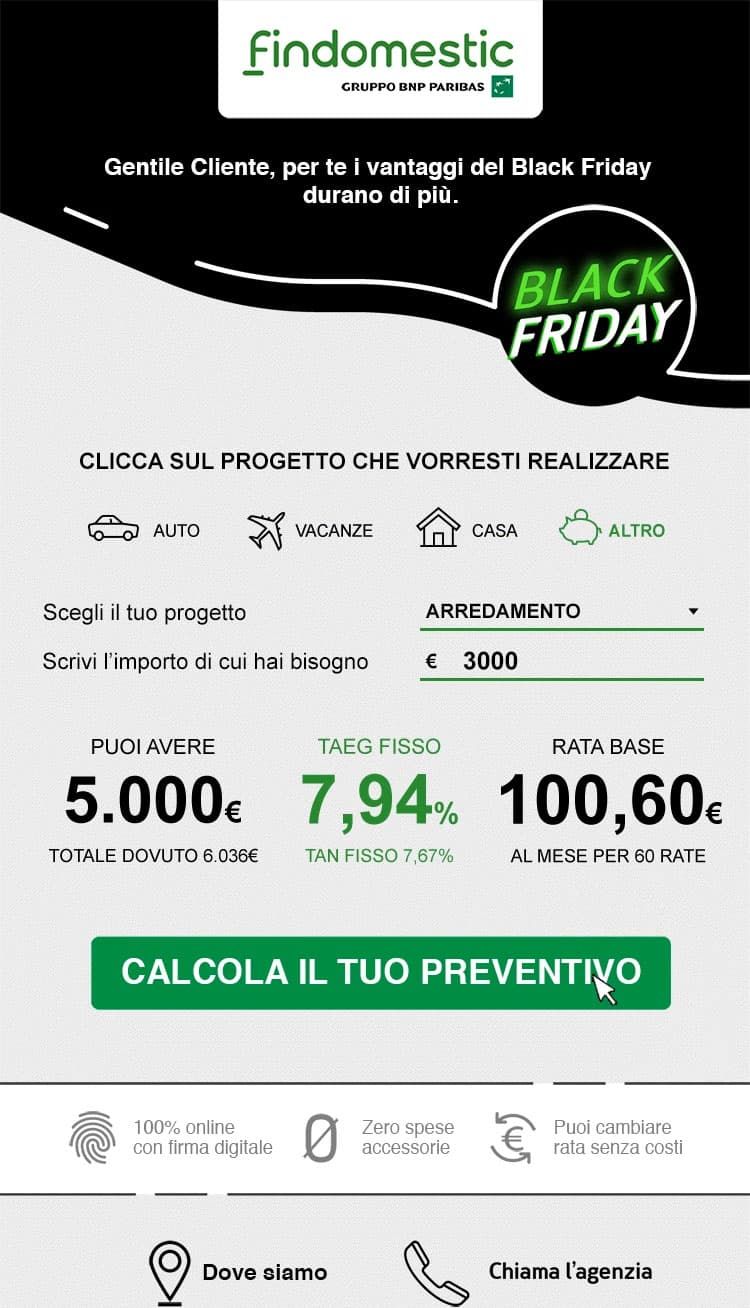
Source: AMP developers blog
Related: How Fintech Companies Can Benefit From AMP Emails
AMP Transactional Email Example
Upsells are often overlooked. Yet there's a lot of opportunity to increase revenue with well thought out transactional emails. With these emails, you can provide important information relating to purchases, while also adding value through upsell options.
Take a look at the flight itinerary example below. This email allows the traveler to manage parts of their trip from right within the email. They can add luggage, check flight notices for delays or changes, or upgrade to a better seat by viewing current upgrade sales. Even more functionality could be added to this email, such as in-flight meal selection or the ability to check in.
Note, this example isn't a real case study. It's an email we designed here at Dyspatch to showcase a transactional use case.

Source: Dyspatch
AMP Emails: The Pros and Cons
Implementing AMP emails does include some initial investment. Are the benefits worth this initial setup? That depends on your goals. Here are a few pros and cons to consider:
Check Your Email Address List. If a company's email list doesn't consist of many Gmail addresses or addresses from other supporting clients, AMP emails may not be a good investment, since few recipients will see the AMP layer. Luckily, more email clients are adding AMP support, like Mail.ru, Yahoo Mail, and FairEmail. It’s also worth noting Gmail continues to surge in market share — up 25% YOY. In fact, Gmail is now the top email client across devices. So despite the upfront investment, AMP is worth looking into for the vast majority of brands.
Related: AMP for Email Series: Your Compatibility Questions, Answered
Assess the Risks vs. Rewards. It’s essential to break down the pros and cons for major time investments — especially as an early adopter. Let’s review a quick risks versus rewards checklist to support your decision-making process:
Risks
- Complex coding. AMP is less flexible and more complex than traditional HTML/CSS. As a result, it may take longer for your in-house team to fully understand and exploit the intricacies of AMP code. It’s important to note there are platforms, such as Dyspatch, that help users build AMP emails more easily.
- Longer QA time. The switch to AMP entails more time in the quality assurance stage. Reviewing and testing the interactive elements and fallbacks each time you send out an AMPed up email is part of the process.
- Hacking concerns. Adding a new feature and code into emails creates a new opportunity for hackers. This raises the question of security regarding code, web page, and application delivery through email. Though Google is strict about their privacy and security policies, hackers can often find a way to, well, hack it.
Rewards
- Standing out in a saturated market. At the very minimum, as an early adopter you’ll see the benefits of standing out in the crowded consumer inbox. Get an edge on the competition with real-time, interactive content and by sharing the most up-to-date information with your audience.
- Riding the leading edge of a big wave. With interactivity being one of the hottest trends in email marketing, employing AMP is a turning point for ecommerce businesses. And it’s here to stay. Think about it: a customer can go through most of the buyer journey without ever leaving their email. They can scroll through a tailored set of products, see an AMP lightbox of a product they're interested in, and add to cart without ever leaving their email. The ROI potential is undeniable.
- Building strong customer relationships. Sending great emails isn’t just about short term gain. With the competition brands face today, most have strategies in place for customer retention and brand loyalty. Sending emails that improve the customer experience will pay dividends in the long run.
Tracking the Performance of AMP Emails
With AMP emails, marketers can continue to use the same metrics they’re used to. Most email service providers will insert an AMP compatible tracking pixel and wrap links so metrics like clicks are counted.
There is one caveat we should mention: Apple’s recent Mail Privacy Protection update as of IOS 15 has hampered the effectiveness of tracking pixels making it hard for marketers to glean accurate open rates. No sweat, though! AMP’s inherent interactivity can be used as a metric on its own. For example, by keeping tabs on how many users fill out an AMP-powered survey directly from their inbox, you’ll be able to get a sense of how many people opened your message. Plus, Apple’s simultaneous barring of live content makes AMP for Email even more enticing, since non-AMP-powered live content works in fewer inboxes now.
AMP also provides product managers with a new opportunity to measure and track user engagement too. Want to reduce the friction it takes to invite other users to your app? Include an AMP invite form in your product emails and start measuring and testing how successful it is!
Related: 7 AMP for Email Myths, Debunked
A Step-By-Step Guide to Implementing AMP for Email
Now that you’ve decided to experiment with AMP emails, we’ve got a quick step-by-step guide to show you how! Here's what you need to do to start AMPing up your email marketing and transactional campaigns.
1. Choose the Right ESP
The ESP you choose will depend on what type of AMP emails you want to send. Do you want to send marketing-focused promotional AMP emails or newsletters to drive ROI? Or are you looking to prioritize transactional emails, which focus on the post-purchase experience?
The answer to these questions will determine which ESP you choose. Some ESPs are great for transactional emails, while others are more marketing-focused. And not all ESPs support AMP. So if you’re looking to experiment with both transactional and marketing emails, you may need more than one sender. Here’s a list of supported ESPs:
Note, this list is growing consistently as more ESPs start to support AMP. For the latest version, please visit: AMP Email Support
| ESP | Category | Transactional | Marketing |
|---|---|---|---|
| Adobe Campaign Classic | Omnichannel marketing | ✓ | |
| Amazon Pinpoint | Omnichannel marketing | ✓ | ✓ |
| Amazon Simple Email Service (SES) | Omnichannel marketing | ✓ | ✓ |
| AWeber | Email Marketing | ✓ | |
| Blueshift | Customer Data Platform, Omnichannel marketing | ✓ | ✓ |
| Braze | Omnichannel marketing | ✓ | |
| Cheetah Digital | Customer Data Platform, Omnichannel marketing | ✓ | |
| Clang | Marketing automation | ✓ | |
| Copernica | Marketing automation | ✓ | |
| Customer.io | Customer Data Platform, Omnichannel marketing | ✓ | ✓ |
| dotdigital | Customer Data Platform, Omnichannel marketing | ✓ | |
| Elastic Email | Email marketing automation | ✓ | |
| eSputnik | Omnichannel marketing | ✓ | |
| ExpressPigeon | Email marketing | ✓ | ✓ |
| Iterable | Omnichannel marketing | ✓ | |
| Klaviyo | Email marketing | ✓ | |
| MagNews | Omnichannel marketing | ✓ | |
| Mailrelay | Email marketing | ✓ | |
| Mapp Cloud | Customer data platform, Omnichannel marketing | ✓ | |
| Maileon | Email marketing | ✓ | |
| Mailgun | Transactional email | ✓ | |
| Mailkit | Email marketing | ✓ | |
| MessageGears | Omnichannel marketing | ✓ | |
| MindBox | Customer data platform, Omnichannel marketing | ✓ | |
| MoonMail | Email marketing | ✓ | |
| Pepipost | Transactional email | ✓ | |
| Salesforce | Customer relationship management platform | ✓ | ✓ |
| SendPulse | Omnichannel marketing | ✓ | ✓ |
| SocketLabs | Email marketing, transactional email | ✓ | ✓ |
| SparkPost | Email and analytics platform | ✓ | |
| Tripolis | Omnichannel marketing | ✓ | |
| Twilio SendGrid | Email marketing, transactional email | ✓ | ✓ |
Related: Salesforce Marketing Cloud Now Supports AMP for Email
2. Build an AMP Email Template
If your ESP supports sending AMP emails, the next step is to build an AMP email. You’ll need this email before you can register with Google. You can do this one of three ways:
Code it yourself. To build a proper HTML/AMP email, several components of code need to be included, as shown in the snippet below:
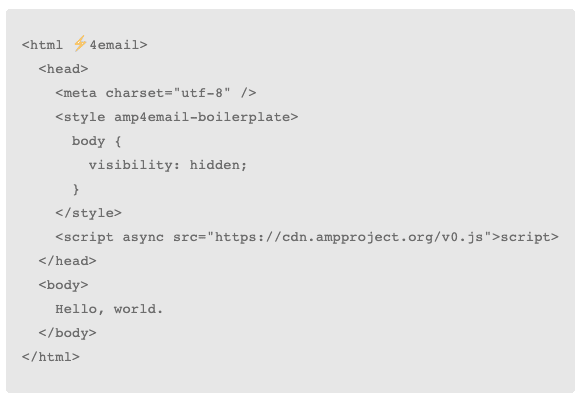

Source: AMP
These AMP components can be split into three categories: dynamic content, layout, and media, each with ‘amp-’ prefacing their tags. If you’re really AMPed up to code it yourself, check out this blog post for Google’s step-by-step process.
Use Gmail’s AMP samples in the Playground. Google’s Playground can help you write and test your AMP emails. With Playground, there’s minimal coding required — just replace the sample content with your own. Simply build the AMP elements, copy the code, and then paste it in your HTML email template.
Use an email builder to do it for you (recommended). Prefer not to code it yourself? Dealing with limited resources? Want to stand out from the competition? Consider trying an email production platform, like Dyspatch, to save time and reduce the likelihood of mistakes. With an email builder, you’ll be able to create amazing-looking emails by simply dragging and dropping pre-coded AMP blocks.
Related: Create AMP Emails in Dyspatch With our Pre-Coded Templates
Have your AMP email ready to go? You'll need to ensure it's AMP-compliant before you move on to step three:
- Ensure you meet all the security requirements.
- Along with an AMP version of an email, you need to include plain text and HTML versions. They'll be used as a fallback version if the AMP one can’t be displayed.
- The AMP layer needs to be smaller than 200KB in size.
- The AMP version of an email must contain a valid AMP document. Read how to validate it here.
3. Register With Google
The next step is to review Google's AMP sender guidelines. Before registering with Google to get your sender domain whitelisted, you'll want to make sure you meet all the requirements. Don’t forget to test your email first as part of the guidelines.
Whitelisting your domain is an essential, one-time requirement that gives you permission to send dynamic content with AMP. Whitelisting also tells spam filters your emails are safe to deliver to the subscriber’s inbox.
There are security reasons for whitelisting. There’s a strong advantage when an email service whitelists senders, giving them permission to send AMP campaigns. Plus, Google individually verifies each sender with a strict security checklist — essential before they roll out AMP to over a billion users.
The same process applies for Verizon, Mail.ru, Yahoo, and AOL email clients. As AMP is a Google-owned technology, you can use the same form to register your domain.

AMP for Email FAQs
Depending on your business needs, you might have a few questions when considering AMP:
- Does AMP support localized emails? Yes. Dyspatch, an email production platform, can help you create localized AMP content.
- Does AMP content expire? Yes. Gmail will only render the AMP layer for 30 days after it’s sent. After 30 days, emails will display the HTML fallback.
- Can I use personalization in AMP emails? Yes. Sixty-five percent of marketers rated the dynamic content in email as their most effective personalization tactic. With AMP, content like weather reports, prices, and webinar dates can update within the email. So subscribers will receive highly-personalized content on demand.
- Does sending AMP emails cost money? There's no additional cost required to send an AMP email.
- Can you forward AMP content? Yes, but the person to whom you forward the email will only see the HTML fallback.
- How do I preview an AMP email? Previewing and testing is always a good idea, especially when you’re dealing with personalized, interactive, and dynamic emails. For AMP-powered emails, the only way is to send the test message to various email clients, or leverage a platform like Litmus. Before you send an AMP email, you can do a preliminary test on the AMP for Email Playground from Google. This free environment allows you to develop, test, and validate your AMP emails before sending. For more information, click here.
- Are there security risks with AMP emails? Yes, but don’t panic. While there are potential pitfalls owing to the fact that AMP blocks transfer information to and from external servers (endpoints), safeguards exist to prevent the exploitation of user data. For one, anyone who wishes to send AMP emails must first be reviewed and whitelisted by Google, a process we describe here. Another failsafe stems from the fact that 3rd party features in AMP emails are limited, and ad components are forbidden entirely. Add to that AMP’s HTML fallback requirement, which works to preserve the original email content as it was intended to be sent, along with its 30 day expiry window, and you’ll see AMP emails offer more than sufficient protection against security threats.
- Will AMP emails take more time to create? It depends. While the need to create an HTML fallback for any AMP-powered email content does require an extra layer of coding be applied to each email (note: This on its own necessitates an understanding of AMPHTML language, which arguably adds more time and complexity to the process), you can skip the hassle entirely by opting to use Dyspatch’s email builder and Apps in Email. Dyspatch takes the heavy lifting out of AMP email creation with its modular, no-code design, allowing you to drag-and-drop AMP content directly into your emails while automatically generating the HTML fallback for you. This means you’re able to reap all the benefits of AMP for Email without having to expend time or resources coding either layer yourself.
- What email clients support AMP emails? Gmail, Yahoo Mail, Mail.ru, and FairEmail currently support AMP content. As marketers continue to open up to the interactive possibilities of AMP emails, more are expected to follow. In fact, Yahoo recently added full AMP support, whereas before they only supported AMP for Yahoo mail on the web. For the latest information, please visit: AMP Email Support.
- What is the return on investment (ROI) of AMP for Email? In a word, huge. Litmus reports that dynamic and live email content increase email ROI by 100% and 107% respectively — meaning that for every $1 invested, $56 are generated. AMP emails have similarly been shown to produce even more dramatic results. Brands that have invested in AMP emails have increased user productivity, click-through, conversions, and abandoned cart recovery rates, which you can read more about here.
AMP is the Future of Email
AMP for Email brings a wealth of new opportunities to stand out in saturated customer inboxes.
What's more, AMP is already proven to deliver significant ROI compared to standard HTML emails. And with adoption from ESPs and marketing automation platforms growing every day, we foresee AMP will redefine how marketers build relationships with their customers — through both transactional and marketing emails.
About Dyspatch
Dyspatch is an email production platform that helps teams build emails quickly, without needing to write code. With our pre-coded AMP blocks, non-technical users can build interactive email templates in half the time and send through their current ESP. Learn more about Dyspatch’s AMP for Email.
